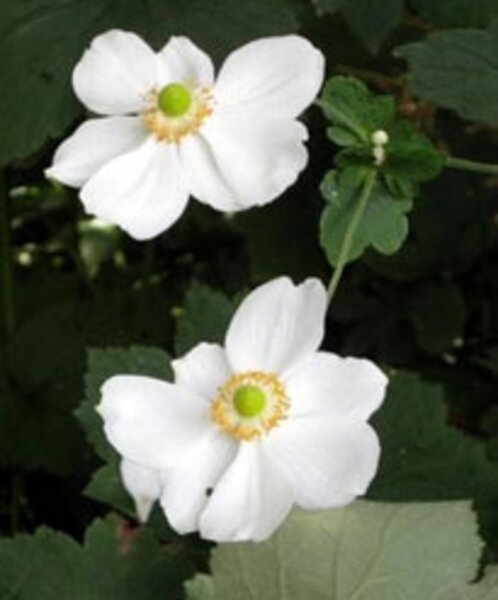Anemones for autumn
Loading...
Traditionally a fall garden exhibits mounds of chrysanthemums, flamboyant asters, and dahlias the size of dinner plates.
Riots of color, these perennials are hallmarks of autumn. Equally beautiful – yet quiet and unassuming – is the Japanese anemone, an elegant lady that holds her delicate flowers high above her head.
In many gardens, she’s the harbinger of autumn, blooming from August until the first frost.
Japanese anemones are perennials that die back in the winter and come back in the spring. The term “Japanese anemone” is used to describe four anemone species that bloom in the fall (as opposed to several anemones that bloom in the spring). From these, many cultivars have been bred to flower in colors ranging from violet to pink to pure white.
Flowers are daisylike and can have single rows of four to six tepals (botanically not a true petal but it looks like one), semidouble, or double rows of more than 30 tepals.
In the spring, the dark-green, maplelike leaves emerge and stay low to the ground. The plant has a clumping habit but has been known to spread via rhizomes (underground stems). However, it is not invasive and does not self-seed.
In July, buds appear and rise above the clump on long, wiry stems. Before long, multitudes of flowers begin to bloom alongside pearllike buds, creating a stratosphere of pastel lace several feet above the foliage.
The beauty is not just in the flower but in the juxtaposition of the round buds against the long, oval “petals.”
The foliage is equally stunning; on some plants it seems to rise as the plant blooms, creating collars just beneath the flowers. Like kinetic sculpture, the wiry stems sway in the breeze, moving the buds and flowers as one.
Because Japanese anemones bloom in autumn, spring planting is recommended to give the roots time to become established before the plant begins channeling energy into flowers.
Japanese anemones grow best in light shade or in areas with morning sun and afternoon shade. They need a moist but well-drained soil; they aren’t drought tolerant. In many areas of the country, they can live in full sun provided they are given ample moisture.
The plants’ height depends on the particular cultivar, but can range from two to four feet when in bloom.
For best effect, plant a mass of Japanese anemones instead of just one or two.
Most Japanese anemones are considered hardy to Zone 5 (winter temperatures no lower than minus 20 degrees F.)
Recently, the Chicago Botanic Garden evaluated 26 cultivars during a six-year study. Science and research staff at the Plant Evaluation Program examined the general plant health, length of blooming period, winter hardiness, and habit quality (tendency of flowers to flop given the long, thin stalks).
“We had a good representation of color and size,” said Richard Hawke, plant evaluation manager. “These anemones are grown all across the country from the East Coast to the West Coast.”
Plants were scored on a five-point scale, with five being tops. Although none received the “excellent” rating of 5.0, three received 4.5: Andrea Atkinson (single to semidouble, white flowers), Max Vogel (semidouble, pink), and Serenade (semidouble, pink). (See the entire list at www.chicago-botanic.org/downloads/planteval_notes/no25_anemones.pdf.)
One important factor in the ratings was the plant’s ability to survive the winter.
The primary reason why a plant did not score well was due to winter wetness,” says Mr. Hawke. Although the evaluation garden is in Zone 5, it’s not winter cold that kills an anemone but soil that retains water during cold weather.
“I love the plant,” Hawke says. “The foliage is attractive, the round buds are cool, and there is great movement in the wind when it blooms.”





